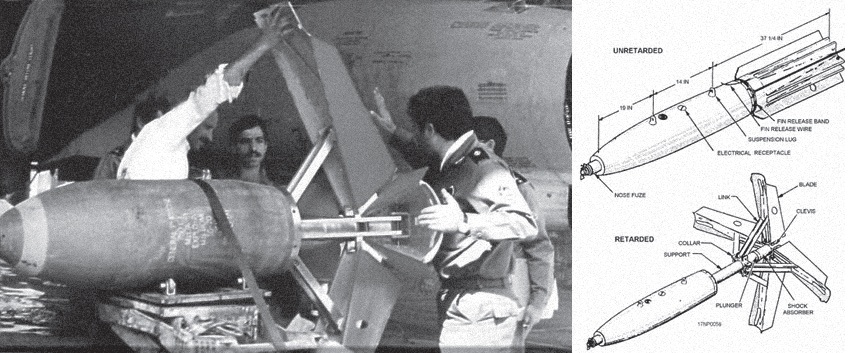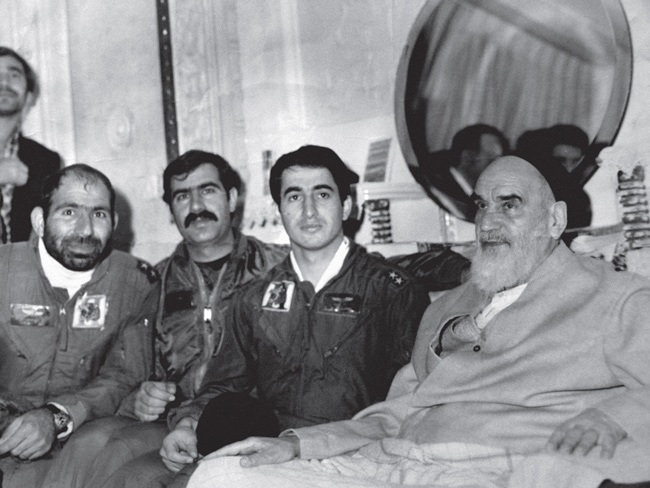Air Raid to Al-Waleed (25)
The Story of Demolishing Fighters and the Equipment in Al-Waleed Triple Military Bases Known as H-32016-06-25
Air Raid to Al-Waleed (H-3)
The Story of Demolishing Fighters and the Equipment in Al-Waleed Triple Military Bases Known as H-3
By: Brigadier General Ahmad Mehrnia
Tehran, Sooreh Mehr Publications Company
2010 (Persian Version)
Translated by: Zahra Hosseinian
At the same time Phantoms were fueling, flight brief of a team of three F-5 aircraft, with the reference of ‘Hormuz’, and led by First Lt. Mostafa Ardestani began. It was planned that this team attack the important facilities in the Kirkuk shortly before the bombing of three H-3 bases by Phantom pilots, so the enemy focused on them and the third refueling of Phantoms to be done. After the preliminaries, they were headed to the hangars. Three F-5 aircrafts, each one equipped with four 500-pound bombs, must bomb Kirkuk refinery at measured time, otherwise it might happen complex conditions and the end of H-3 mission faced with disaster.
Number three of this flight team, which was flying in the right side of leader’s aircraft, was brave and spirited First Lt. Pilot Shafi Hosseinpour who had prevented continuing influence of enemy during effective raids to enemy’s armored instrument and forces, with excellent flight skills in the early days of the war, along with several colleagues. Also First Lt. Pilot Mohammad Ibrahim Tavakoli, as number two on the left side of leader’s aircraft, one after another maximized engines power in a few seconds. The roaring sound of their aircrafts broke the silence of this beautiful sunny spring day and left the base towards the target.
Hosseinpour, who is the sole survivor of that three aircraft flight[1], says:
"Around 6 Am our home phone rang and wanted me to go to the command post. Reaching there, First Lt. Mostafa Ardestani and Tavakoli were too. Lt. Col. Farzaneh, base commander, also arrived and briefed us carefully about the importance of the mission. He said that due to the long low flight into enemy territory and established defense along the way and around the target, the risk of mission is very high. It has been planned that you attack to Kirkuk refinery at the determined time and bomb it. Then, intelligence officer showed us a clear photo of target and specified its sensitive parts.
We prepared necessary maps and went to a private room for flight brief, type of tactic and how to attack, by the Leader Ardestani. It was decided that Tavakoli fly in the number two position and I fly in the third one. At the appointed time we were on the runway and ready for flight, and by maximizing engine power, we took off. As they had been noted, we flew at altitudes below a hundred feet. I was number three, so it was very difficult for me. Absolute radio silence was also on the agenda, so we must not exchange any word between ourselves. Fortunately, everything went on fine and we approached the target at the appointed time without any delay. Despite base and refinery of Kirkuk was one of dangerous targets for the Tabriz base, and had very good and strong defense, but the remembrance of Allah and ensuring of leader’s skills and his experiences during few months of the war, made me very calm. I was not worried at all. The mission was implemented exactly according to the plan. Considered refinery burned under the fire of Iranian bombardment for several times. Complete radio silence and flying at very low altitude surprised the enemy completely.
At the time, we often bombed in the form of diving from high altitude, but in this mission it was supposed to use skip technique – that is fixed low-altitude bombing, with MK-84 bombs which has small wings, so they reach to the ground with delay, and we have a chance to get away from the shrapnel of our bombs. With a click on the radio (short press on the radio button) by Leader, we switched on the ammunition in the pre-determined position, and we took attack status. With almost tactical distance we all were above the target beside each other. We climbed and reached to near 200 feet and simultaneously released bombs on three crucial points of big Kirkuk refinery.

Testing and installing winged-bombs on the aircraft. Right: Schema of open and close wings.
Leadership of Mustafa was excellent. He was a courageous, faithful, and honorable pilot. In the previous missions, he could find targets very good and effectively had destroyed them. This time it was wonderful too. Before observing the hit point of bombs, we were assured about the extent of damage and their effect, because all the criteria had been accurate. After bombing, Ibrahim immediately turn to the right and became so close to me that if I didn’t keep my wits and didn’t climbed with a quick reaction, we both collided to each other above the target. I was surprised by his action and then adjusted my height. With a mild 180 degrees circulation, I kept flying toward our country boarder, while I considered the leader and located beside the Mostafa’s aircraft. Dense smoke had been raised from refinery in the air, and the enemy defense, which couldn’t still collect itself, fire indiscriminately in every direction; but due to that early circulation, Ibrahim had lost us and had been forced to go back alone until near the border.
After landing, I complained to Ibrahim. He apologized and said: "because of much joyfulness and seeing how well my bombs hit the target, I forgot you are at the right of me." Truly God have mercy on us that a successful mission not combined with harrowing incident.
In the returning rout, we heard the voice of radar control officer who messaged us that Iraqi fighters are flying toward us and asked to leave enemy territory more quickly. The leader increased his speed briefly and I was with him in flight at the combat situation. Near our border in the region of Iraqi Kurdistan, we saw a large military force with tanks and other equipment were shifting towards our border. I took the opportunity and accompanied with Mustafa burst them with machine gun and made them frightened, and disrupted their arrangements. During firing, a fantastic film was recorded by aircraft cameras which showed the importance and talent of forces.
Immediately after landing, we reported the results of operations and the forces that we had seen, to the base command and its operation information.
Hours later, when I heard about the successful attack to H-3 and effective destruction of targets that led to our happiness and pleasure, I realized that our mission was a harassment operation for them and in fact we had been prey!
Due to Ardestani’s insistence, base commander allowed me and Mostafa to attack above-mentioned forces again on the same afternoon. As these forces had not been deployed properly and had not consolidated its position, we raised a hell for them and inflicted heavy damages on them. By God willing, and Ardestani’s good leadership and guidance, the result of this operation was excellent. Later, according to the evidence and information which was received from influential elements of Iran, it was reported that they might be Jordanian forces who had been presented there to help behind the front line of Iraq. This bombardment was also filmed very good which should be existed in the records.
The best of all this efforts was when we went to visit the great leader of the Revolution. I have great respect for his charismatic personality and one of my dreams was to see this decisive and brave personality. Thankfully this wish was fulfilled very soon and only a few days after the mentioned operation we visited him. Still the enlarged photo of that visitation is on the wall of my house and seeing it, I remember those contented heroes, like great martyr Ardestani and other fellow comrades and I’m proud of the sacrifices. It was so the memory of harassment operation related to the bombing of "Al-Waleed" always has engraved in my mind."

Meeting with the leadership, from right: Imam Khomeini (RA), First Lt. Shafi Hosseinpour, First Lt. Mostafa Ardestani, and First Lt. Mohammad Ibrahim Tavakoli.
Since the Iraqi fighters are flying toward them for intercepting the flight of three aircraft team, radar officer immediately ask the two F-5 team deployed at the South Lake to fly toward border and help them. Receiving momentary information about the direction and speed of enemy fighters, they also cross into Iraq at the average height, and because are better exposed to Iraqi radars, fighters redirect toward them. Given the lack of fuel, insider pilots supported by Tomcat try to drag enemy fighters into insider territory with radar guidance and battle with them in a better position; but the enemy gives up from continuing the pursuit after approaching the borders of Iran. The same tactics and partnership make the space safer for three aircraft team and they return safely to the Tabriz base.
It should be noted that, in this day, a helicopter had flown from Tabriz base and deployed near the border in a safe place, so that if possibly an aircraft have an accident and its pilot/pilots needed help, quickly rescued them. This mission that is called search and rescue is very important for all air operations and the presence of veteran officers encourage pilots of fighters. Unfortunately, it is not possible to find the name of pilot and crews of this helicopter.
[1]. In the moments of sunrise on October 30th 1981, Capt. Pilot Ibrahim Tavakoli met with an accident and martyred in the North East of Ahvaz, while headed from Dezful air base to attack targets in enemy territory. God Bless Him. On January 5th 1995, Amir Brigadier General pilot Mustafa Ardestani, who was the record holder of abroad missions among colleagues, along with then commander of Air Force, Amir Maj. Gen. Mansour Satari, and some of the commanders on the operational journey with a Falcon aircraft when had an accident in the air region of Isfahan and all martyred. God bless them.
Number of Visits: 7207
http://oral-history.ir/?page=post&id=6420
